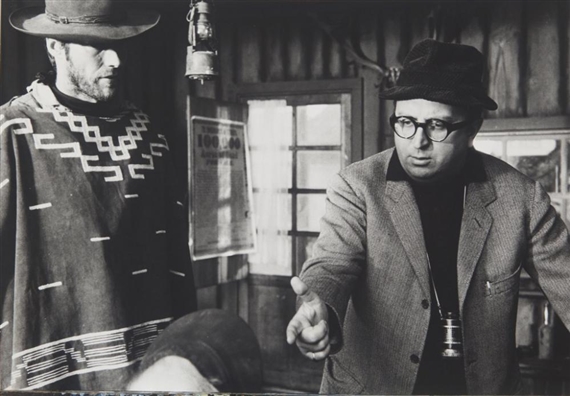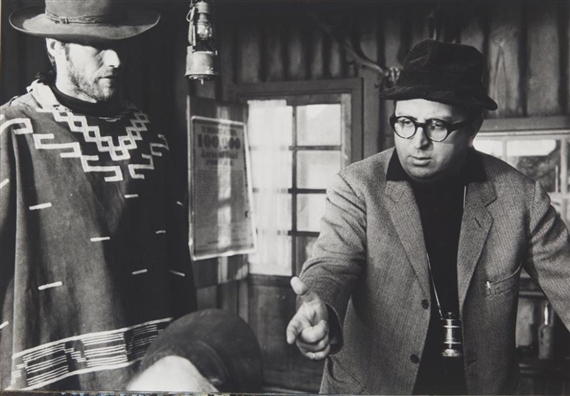EPISODE 17: The Bromance At Cinecittà
It is said somewhere in the far west, in the mid 1960’s, a modestly successful television actor found out in a newspaper he was a sensation overseas in Italy. The praise of an eager Italian audience was for a job the actor took while on hiatus for his television show. That summer at the industrious (if not supremely respected) Cinecittà Studios, a small yet intense Western was made that would change the television stars life and the Western genre for decades to come.
Undoubtedly, the actor looked at the news and uttered in a gruff manner, “Swell!”
——
We can speculate to the end of time what may have happened if Clint Eastwood hadn’t decided to take a chance in going to Italy to star in a series of Westerns by a then unknown Sergio Leone. Would his stint on Rawhide led to anything bigger? Perhaps. Would the Western genre still have changed dramatically with A FISTFUL OF DOLLARS if original choice Charles Bronson had accepted the role of Joe? Perhaps (although I genuinely have a hard time thinking of that notion without a burst of laughter). Undeniably, we have to always look at this as one of those oft told instances of timing and luck. That serendipity on which Hollywood and film making lore thrives upon to retain it’s place in the worlds history books. For many, nothing beats a triumphant story of something coming out of nowhere and changing the game for the better. The turbulent but productive working relationship between Leone and Eastwood created tones and notions to the Western genre that we continue to witness today.
The films of THE DOLLARS TRILOGY are bold experiments in limit pushing, released at a moment in history that relied too heavily on outdated heroics and antiquated limits. When the films all arrived into American cinemas months apart from each other in 1967, they were met critically with the conditioning of antiquated taste. Among the expletives thrown around by the critics of that era was the term “Spaghetti Western”, as if to dismiss this European attempt at what was considered a genre that shouldn’t be touched by hands outside the U.S. They detested, among many things, the brutality of its hero and the brutality he conducts.
Clint’s portrayal of “The Man With No Name” (an utter misnomer, as he has a name in each one of the films despite donning the same wardrobe) sparked a flame of true and raw Western attitude. His cowboy status is actually of a con man gunslinger who still stands for something. An Anti Hero if there ever was one, his characterization added much needed depth as discussed in previous articles. In the Dollars Trilogy specifically though, it is unhinged. Few moments with him in these films show emotional vulnerability, and the majority lends heavily to Leones brutal and (realistically accurate) view of the attitudes and mentalities of the West.
Today of course, “Spaghetti Western” as a term is more positively synonymous with the necessary evolution of genre that had been rotting in television for the better part of a decade prior to the Bromance at Cinecittà that ushered in more possibilities for Westerns and cinema as a whole. It’s the legacy that Eastwood will carry even beyond his mortal years, and one I imagine he shares more than gladly with Lone in his head and heart.
The Trilogy itself, shows progression and development along the way. Each film is a step forward that adds more heft and weight as they move along. And it is more than interesting to watch that unfold back to back to back.
So lets experience the evolution of a genre in one big burst as we see the exploits of Joe, Manco, and Blondie.
(Note: all the films are 4 stars, as each possess their own strengths that make them great individually, so we will forego the silly arbitrary rating system for this article).
A FISTFUL OF DOLLARS
Essentially a Western set remake of Kurosawa’s YOJIMBO, A FISTFUL OF DOLLARS tells the story of Joe (Clint), also known as ‘The Stranger’ riding into the town of San Miguel and plays both sides of a bitter rivalry between two factions vying for control in the town. Along the way, Joe’s double dealing takes a toll that must be rectified with vengeance come films end. The film is truly the baby step in the whole affair, starting with a fairly simple Western premise that leans heavily on the grungy and greedy side of humanity with Eastwood looking out for himself. When the film does turn to traditional characters turns, they are not without ambiguity and a brutal beating. This film virtually kicks the door open for these antiheroes, and Eastwood kicks the door down pretty beautifully. His presence sells it. It’s the thing he has in his back pocket ever and always. Any other actor put into this role at that time would have been laughable. The stoic poise that carries undeniably rage is present throughout his scenes and combined with Leone’s gift with the Close Up, you watch an Icon be birthed in your very presence. You see in that very film how you can give a man like him the career he’s had for how long he’s had it.
FOR A FEW DOLLARS MORE
If A FISTFUL OF DOLLARS was a baby step, FOR A FEW DOLLARS MORE is a bigger step towards and into adulthood. Eastwood plays Manco, a brutal bounty hunter with no penchant for how he gets the job done. Manco is on the trail of El Indio (Gian Maria Volonté), a ruthless criminal with an equally ruthless gang. Coincidentally, El Indio has another bounty hunter on his trail in the form of Col. Douglas Mortimer (an amazing Lee Van Cleef), who may have more than just a reward weighing on his mind and heart. Mortimer and Manco eventually team up and pursue the bounty together with the result being an all out fight to victory both material and personal. FEW DOLLARS MORE not only ups the ante on the violence and the broader abilities of storytelling, it adds wonderful character dynamics. It is more noticeable in Van Cleef, who’s character holds back in a much more aware way than Clint’s character can. Yet within those few vulnerable moments where Clint’s dynamic is given an extra coating of empathy and contemplation, you see that antihero get an extra dose that makes this second outing more than just the middle of an influential trilogy. It wouldn’t be unfair to say this film may be the most interesting because it balances simplicity and complexity rather well in the most surprising way.
THE GOOD, THE BAD, AND THE UGLY
As many times before in this series, we are walking into the “Cave of Classic’s” (No, I dont like that term either, but here we are ladies and gentlemen). THE GOOD, THE BAD, AND THE UGLY is of the most, if not the most, iconic film in Estwood’s career. Where the first two film is the trilogy have more than strong footing, the final film in the Dollars trilogy has entered the public language in a way few films manage too from it’s breathtaking visuals, superb cast, and iconic score by Ennio Morricone (who also scored the first two). The story follows Blondie (Eastwood), Angel Eyes (Lee Van Cleef), and Tuco (the genius Eli Wallach). Three selfish men of dastardly deeds who are all in search of a stash of gold buried in the Sad Hill Cemetery. What follows is a search for wealth amidst the backdrop of the brutality and devastation of the American Civil War, with our three titular souls reckoning with their roles in a world that has gone mad. In the film, the transformation of the new, brutal, and honest western is virtually complete. It’s secret new ingredient is thematic heft, giving the Blondie character a moment to tap into his personal opinions and beliefs while still keeping the image he holds in the first two. A particular scene involving a fallen Union soldier and Eastwood handing him a bottle of half drunk liquor as a message of comfort following a bloody conflict is more depth and range than half the Western characters that came before him would do in one movie. Added to that is a sense of humor, albeit dark and riddled with vicious intent. It’s a mode of humor that Clint would use later in his persona, and one he contributes to the greater chunk of more modern Westerns. It is an unquestionable masterpiece of film, and one that has not grown tiresome in the slightest.
——-
And when all is said and done, Clint left Cinecittà and the Spaghetti Western behind following his time with Leone. It is well known that the two clashed consistently and that Eastwood was ready to move on.
Sergio Leone reaped enormous benefits and frustrations from the collaboration, but was taken too soon in 1989. Around that time, Clint must have been reflecting on that and so much more. Because what he gave us three years later must have been his love letter to the Italian director who changed his life forever…. and we shall chat about it next time.


